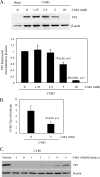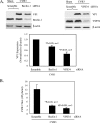Autophagosome supports coxsackievirus B3 replication in host cells
- PMID: 18596087
- PMCID: PMC2546883
- DOI: 10.1128/JVI.00641-08
Autophagosome supports coxsackievirus B3 replication in host cells
Abstract
Recent studies suggest a possible takeover of host antimicrobial autophagy machinery by positive-stranded RNA viruses to facilitate their own replication. In the present study, we investigated the role of autophagy in coxsackievirus replication. Coxsackievirus B3 (CVB3), a picornavirus associated with viral myocarditis, causes pronounced intracellular membrane reorganization after infection. We demonstrate that CVB3 infection induces an increased number of double-membrane vesicles, accompanied by an increase of the LC3-II/LC3-I ratio and an accumulation of punctate GFP-LC3-expressing cells, two hallmarks of cellular autophagosome formation. However, protein expression analysis of p62, a marker for autophagy-mediated protein degradation, showed no apparent changes after CVB3 infection. These results suggest that CVB3 infection triggers autophagosome formation without promoting protein degradation by the lysosome. We further examined the role of the autophagosome in CVB3 replication. We demonstrated that inhibition of autophagosome formation by 3-methyladenine or small interfering RNAs targeting the genes critical for autophagosome formation (ATG7, Beclin-1, and VPS34 genes) significantly reduced viral replication. Conversely, induction of autophagy by rapamycin or nutrient deprivation resulted in increased viral replication. Finally, we examined the role of autophagosome-lysosome fusion in viral replication. We showed that blockage of the fusion by gene silencing of the lysosomal protein LAMP2 significantly promoted viral replication. Taken together, our results suggest that the host's autophagy machinery is activated during CVB3 infection to enhance the efficiency of viral replication.
Figures









Similar articles
-
Inhibition of Histone Deacetylase Activity Aggravates Coxsackievirus B3-Induced Myocarditis by Promoting Viral Replication and Myocardial Apoptosis.J Virol. 2015 Oct;89(20):10512-23. doi: 10.1128/JVI.01028-15. Epub 2015 Aug 12. J Virol. 2015. PMID: 26269170 Free PMC article.
-
The cytotoxicity of coxsackievirus B3 is associated with a blockage of autophagic flux mediated by reduced syntaxin 17 expression.Cell Death Dis. 2018 Feb 14;9(2):242. doi: 10.1038/s41419-018-0271-0. Cell Death Dis. 2018. PMID: 29445155 Free PMC article.
-
Coxsackievirus B3 infection induces autophagic flux, and autophagosomes are critical for efficient viral replication.Arch Virol. 2016 Aug;161(8):2197-205. doi: 10.1007/s00705-016-2896-6. Epub 2016 May 25. Arch Virol. 2016. PMID: 27224983
-
Impaired autophagy and APP processing in Alzheimer's disease: The potential role of Beclin 1 interactome.Prog Neurobiol. 2013 Jul-Aug;106-107:33-54. doi: 10.1016/j.pneurobio.2013.06.002. Epub 2013 Jul 1. Prog Neurobiol. 2013. PMID: 23827971 Review.
-
Coxsackievirus B3 replication and pathogenesis.Future Microbiol. 2015;10(4):629-53. doi: 10.2217/fmb.15.5. Future Microbiol. 2015. PMID: 25865198 Review.
Cited by
-
TBK1 and GABARAP family members suppress Coxsackievirus B infection by limiting viral production and promoting autophagic degradation of viral extracellular vesicles.PLoS Pathog. 2022 Aug 31;18(8):e1010350. doi: 10.1371/journal.ppat.1010350. eCollection 2022 Aug. PLoS Pathog. 2022. PMID: 36044516 Free PMC article.
-
Viruses and autophagy: bend, but don't break.Nat Rev Microbiol. 2024 May;22(5):309-321. doi: 10.1038/s41579-023-00995-y. Epub 2023 Dec 15. Nat Rev Microbiol. 2024. PMID: 38102460 Review.
-
Nrf2 Pathway and Autophagy Crosstalk: New Insights into Therapeutic Strategies for Ischemic Cerebral Vascular Diseases.Antioxidants (Basel). 2022 Sep 2;11(9):1747. doi: 10.3390/antiox11091747. Antioxidants (Basel). 2022. PMID: 36139821 Free PMC article. Review.
-
Epigallocatechin-3-gallate opposes HBV-induced incomplete autophagy by enhancing lysosomal acidification, which is unfavorable for HBV replication.Cell Death Dis. 2015 May 21;6(5):e1770. doi: 10.1038/cddis.2015.136. Cell Death Dis. 2015. PMID: 25996297 Free PMC article.
-
Picornavirus infection induces temporal release of multiple extracellular vesicle subsets that differ in molecular composition and infectious potential.PLoS Pathog. 2019 Feb 19;15(2):e1007594. doi: 10.1371/journal.ppat.1007594. eCollection 2019 Feb. PLoS Pathog. 2019. PMID: 30779790 Free PMC article.
References
-
- Blommaart, E. F., U. Krause, J. P. Schellens, H. Vreeling-Sindelarova, and A. J. Meijer. 1997. The phosphatidylinositol 3-kinase inhibitors wortmannin and LY294002 inhibit autophagy in isolated rat hepatocytes. Eur. J. Biochem. 243240-246. - PubMed
-
- Codogno, P., and A. J. Meijer. 2005. Autophagy and signaling: their role in cell survival and cell death. Cell Death Differ. 12(Suppl. 2)1509-1518. - PubMed
Publication types
MeSH terms
Substances
Grants and funding
LinkOut - more resources
Full Text Sources
Other Literature Sources
Miscellaneous

